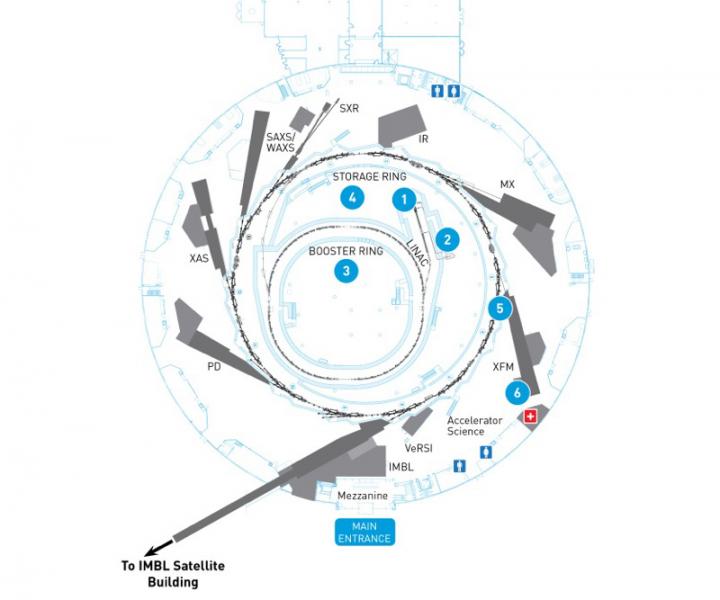

What is synchrotron light?
How is synchrotron light created?
The Australian Synchrotron produces incredibly bright light in frequencies ranging from infra-red to hard X-rays, for the purpose of enabling high-impact research across a broad array of disciplines.
It works by accelerating a beam of electrons to nearly the speed of light inside a circular vacuum chamber hundreds of meters in circumference, called a storage ring. To do this, a complex of particle accelerators is required.

Electrons are first generated by the electron gun (1) in the centre of the synchrotron and accelerated to 99.9997% of the speed of light by the linear accelerator, or linac (2). The electrons are then transferred to the booster ring (3), where they are increased in energy from 100 MeV to 3,000 MeV (or 3 GeV) in about half a second. They are then transferred to the outer storage ring (4).
The electrons are circulated around the storage ring by a series of magnets separated by straight sections. As the electrons are deflected through the magnetic field, they give off electromagnetic radiation called ‘synchrotron light’. The synchrotron light produced by the synchrotron is emitted in a narrow cone in the forward direction, at a tangent to the electron's orbit, with an intensity that can reach a million times brighter than the sun.
Channelled into experimental workstations via ‘beamlines’, the synchrotron light then interacts with sample materials. A wide array of research is conducted using the synchrotron light, which can be broadly categorised by analysis technique, be it diffraction and scattering, spectroscopy, or imaging. Each beamline is tailored towards a particular technique with specialised equipment.
There are currently 14 operational beamlines at the Australian Synchrotron with plans to expand the suite with an additional four beamlines.
How is synchrotron light created?
Synchrotron light is a special case of a standard process in physics where an accelerating charged particle will generate electromagnetic radiation. Similarly to how radio waves are generated when electrons are accelerated up and down a broadcast antenna via an oscillating voltage, electrons at the Australian Synchrotron emit radiation when they are accelerated along a circular path with magnetic fields.
However unlike electrons in an antenna, electrons in the Australian Synchrotron storage ring are relativistic (meaning that they are travelling at almost the speed of light). As a result, the radiation produced is squeezed by the effects of special relativity into a narrow cone and the wavelength compressed. The resulting synchrotron light covers electromagnetic wavelengths from infra-red through to hard X-rays, with most beamlines utilising the hard X-rays.

What makes synchrotron light unique?
Synchrotron light is unique in its intensity and brilliance, and it can be generated across the range of the electromagnetic spectrum: from infrared to visible light to x-rays. The synchrotron light produced at the Australian Synchrotron is as bright as 1 million suns.
Properties of synchrotron light
Synchrotron light has a number of unique properties. These include:
- High brightness: synchrotron light is extremely intense (hundreds of thousands of times more intense than that from conventional x-ray tubes) and highly collimated.
- Wide energy spectrum: synchrotron light is emitted with energies ranging from infrared light to hard x-rays.
- Tunable: it is possible to obtain an intense beam of any selected wavelength.
- Highly polarised: the synchrotron emits highly polarised radiation, which can be linear, circular or elliptical.
- Emitted in very short pulses: pulses emitted are typically less than a nano-second (a billionth of a second), enabling time-resolved studies.